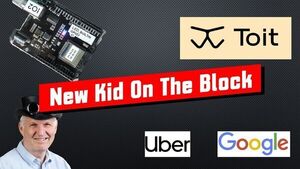2022-02-17 - Nº 355
Editorial
Esta é a Newsletter Nº 355 que se apresenta com o mesmo formato que as anteriores. Se gostar da Newsletter partilhe-a!
Todas as Newsletters encontram-se indexadas no link.
Esta Newsletter tem os seguintes tópicos:
Faz hoje anos que nascia, em 1781, o médico francês René Laennec. Ele inventou o estetoscópio e é geralmente considerado o pai da medicina do tórax. Utilizando um cilindro de madeira com um pé longo que colocou no peito dos seus pacientes, conseguiu ouvir os vários sons feitos pelos pulmões e pelo coração. Durante três anos estudou os sons torácicos dos pacientes e correlacionou-os com as doenças encontradas na autópsia. Descreveu os seus métodos e descobertas no clássico De l'auscultation médiate (1819). Laënnec fez numerosas outras contribuições para a literatura das doenças respiratórias e cardíacas.
Faz também hoje anos que nascia, em 1838, o químico russo Friedrich Konrad Beilstein. Ele dedicou-se à investigação em química orgânica que incluía o estudo de derivados isoméricos de benezeno. O seu legado duradouro, no entanto, foi iniciar a descrição sistemática das compoonias orgânicas, que ele concretizou na publicação do seu Handbuch der organischen Chemie, (1880-82; Handbook of Organic Chemistry). O seu objectivo era que este fosse um catálogo completo, e já na sua primeira edição, os dois volumes descreviam 15.000 compostos. Como a química orgânica continuava a crescer rapidamente, publicou a segunda e terceira edições expandidas. Após a morte de Beilstein, devido ao seu grande valor para os químicos orgânicos, o trabalho de actualização da publicação foi assumido pela Deutsche Chemische Gesellschanft, que continuou a publicá-la".
Faz igualmente hoje anos que nascia, em 1856, o fotógrafo e inventor norte-americano Frederic Eugene Ives. Ele foi o inventor do processo de meio-tom, um método de reprodução de fotografias numa prensa de impressão. Antes deste processo, as fotografias e ilustrações eram reproduzidas a partir de placas gravadas à mão. Desta forma, as impressoras podiam reproduzir desenhos de linha, mas não os tons de cinza numa fotografia, porque as prensas de impressão não podem imprimir a cinza - apenas a preto e branco. Ives inventou um ecrã que converteria uma fotografia num padrão de pequenos pontos. Grandes pontos formam onde a imagem é escura, e pequenos pontos onde a imagem é clara, dando assim a ilusão de tonalidades de cinzento. Em 1881, foi o primeiro a fazer uma impressão a três cores de blocos de meio-tom. Outras invenções em fotografia e impressão a cores renderam 70 patentes.
Faz também hoje anos que nascia, em 1888, o cientista germano-americano Otto Stern. Ele foi vencedor do Prémio Nobel da Física em 1943 pelo seu desenvolvimento do feixe molecular como ferramenta para estudar as características das moléculas e pela sua medição do momento magnético do protão.
Por fim, faz hoje anos que nascia, em 1890, o estatístico, geneticista e biólogo evolucionista britânico Ronald Fisher. Ele deu contribuições para a teoria estatística que se tornaram pilares da prática estatística moderna. Em genética, ele estabeleceu a genética biométrica e estudou o domínio através de experiências de reprodução com vários animais). Desenvolveu métodos de análise multi-variada para rastrear a ligação dos genes a diferentes características. Para evitar a introdução de preconceitos na concepção de experiências que pudessem produzir dados imprecisos ou enganosos, aplicou o seu princípio de aleatoriedade. Enquanto continuava o seu interesse em estatísticas durante os seus cursos universitários, começou a sua carreira como professor de matemática do ensino secundário (1914-19). Durante este tempo, publicou um trabalho (1918) aplicando estatísticas para produzir um teorema fundamental de selecção natural. Prosseguiu o seu estudo de genética na Estação Experimental de Rothamsted como estatístico em 1919.
E nesta semana que passou o Telescópio Espacial James Webb está quase a concluir a primeira fase do processo de alinhamento do espelho primário do observatório com o instrumento Near Infrared Camera (NIRCam), com a duração de meses. O desafio da equipa foi duplo: confirmar que a NIRCam estava pronto para recolher luz de objectos celestes, e depois identificar a luz estelar da mesma estrela em cada um dos 18 segmentos primários do espelho. O resultado é um mosaico de imagem de 18 pontos de luz estelar organizados aleatoriamente, o produto dos segmentos de espelho não alinhados da Webb, todos reflectindo a luz da mesma estrela no espelho secundário da Webb e nos detectores da NIRCam.
Na Newsletter desta semana apresentamos diversas noticias, artigos científicos, projetos de maker e alguns vídeos interessantes. É apresentada a revista Hackspace Magazine Nº 52 de Março.
 João Alves ([email protected])
João Alves ([email protected])
O conteúdo da Newsletter encontra-se sob a licença  Creative Commons Attribution-NonCommercial-ShareAlike 4.0 International License.
Creative Commons Attribution-NonCommercial-ShareAlike 4.0 International License.
Novidades da Semana
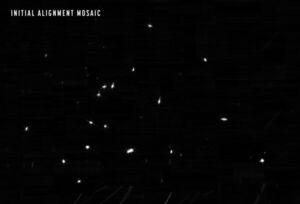
Photons Received: Webb Sees Its First Star – 18 Times
"The James Webb Space Telescope is nearing completion of the first phase of the months-long process of aligning the observatory’s primary mirror using the Near Infrared Camera (NIRCam) instrument. The team’s challenge was twofold: confirm that NIRCam was ready to collect light from celestial objects, and then identify starlight from the same star in each of the 18 primary mirror segments. The result is an image mosaic of 18 randomly organized dots of starlight, the product of Webb’s unaligned mirror segments all reflecting light from the same star back at Webb’s secondary mirror and into NIRCam’s detectors. What looks like a simple image of blurry starlight now becomes the foundation to align and focus the telescope in order for Webb to deliver unprecedented views of the universe this summer. Over the next month or so, the team will gradually adjust the mirror segments until the 18 images become a single star. “The entire Webb team is ecstatic at how well the first steps of taking images and aligning the telescope are proceeding." [...]
Outras Notícias

World's smallest SD card level translator from Nexperia has 40% smaller footprint
"Nexperia, the expert in essential semiconductors, today announced the world's smallest Secure Digital (SD) card level translator IC - NXS0506UP. Housed in a 16-bump wafer-level chip-scale package the SD 3.0-compliant bi-directional dual voltage level translator has a footprint measuring 1.45mm x 1.45mm x 0.45mm, 0.35mm pitch, 40% smaller than previous 20 bump devices. The NXS0506UP also features integrated auto-direction control, EMI filter and IEC 61000-4-2 ESD protection. It is designed to operate at clock frequencies of up to 208 MHz and data rates of up to 104 Mbps. Comments Vikram Singh Parihar, senior product manager at Nexperia: “While traditionally targeted for use in consumer devices such as smartphone handsets, notebooks, game pads, cameras and wireless access points, we are seeing adoption of the NXS0506 in home medical devices and automotive systems. The NXS0506 is the industry’s smallest SD 3.0 card level shifter that supports the ultra-high speed SDR104 mode, helping consumers to experience the faster data rates offered by SD 3.0 memory card solutions."" [...]
Intel to Acquire Tower Semiconductor for $5.4 Billion
"Intel Corporation (Nasdaq: INTC) and Tower Semiconductor (Nasdaq: TSEM), a leading foundry for analog semiconductor solutions, today announced a definitive agreement under which Intel will acquire Tower for $53 per share in cash, representing a total enterprise value of approximately $5.4 billion. The acquisition significantly advances Intel’s IDM 2.0 strategy as the company further expands its manufacturing capacity, global footprint and technology portfolio to address unprecedented industry demand. “Tower’s specialty technology portfolio, geographic reach, deep customer relationships and services-first operations will help scale Intel’s foundry services and advance our goal of becoming a major provider of foundry capacity globally,” said Pat Gelsinger, Intel CEO. “This deal will enable Intel to offer a compelling breadth of leading-edge nodes and differentiated specialty technologies on mature nodes – unlocking new opportunities for existing and future customers in an era of unprecedented demand for semiconductors.” As a key part of its IDM 2.0 strategy, Intel established Intel Foundry Services (IFS) in March 2021 to help meet the growing global demand for semiconductor manufacturing capacity and to become a major provider of U.S.- and Europe-based foundry capacity to serve customers globally. IFS currently offers leading-edge process and packaging technology, committed capacity in the U.S. and Europe and other geographies in the future, and a broad intellectual property (IP) portfolio. Tower’s expertise in specialty technologies, such as radio frequency (RF), power, silicon-germanium (SiGe) and industrial sensors, extensive IP and electronic design automation (EDA) partnerships, and established foundry footprint will provide broad coverage to both Intel and Tower’s customers globally." [...]

STMicroelectronics’ “Intelligent Sensor Processing Unit” Integrates Brains into Sensors to Launch Onlife Era
"STMicroelectronics (NYSE: STM), a global semiconductor leader serving customers across the spectrum of electronics applications and a top manufacturer of Micro-Electro-Mechanical Systems (MEMS), today announced the launch of the Intelligent Sensor Processing Unit (ISPU) that combines a Digital Signal Processor (DSP) suited to run AI algorithms and MEMS sensor on the same silicon. In addition to reducing size over system-in-package devices and cutting power by up to 80%, merging sensor and AI puts electronic decision-making in the application Edge. Here, it facilitates the Onlife Era where innovative products enabled by smart sensors are able to sense, process, and take actions, bringing the fusion of technology and the physical world. The Onlife Era acknowledges living with continuous assistance from connected technologies, enjoying natural, transparent interactions, and seamless transitions, with no discernible distinction between online and offline. With the ISPU, ST is enabling this era by helping to migrate intelligent processing into sensors that support the fabric of life: no longer at the Edge but in the Edge. ST’s ISPU provides substantial benefits in the four Ps: power consumption, packaging, performance, and price." [...]

Renesas and AVL Software and Functions Collaborate on Customer Support for Functional Safety to Develop Automotive ECUs That Comply with ISO 26262
"AVL provides Renesas Customers with Comprehensive Support for Development of Complex and Specialized Functional Safety Systems. Renesas Electronics Corporation (TSE:6723), a premier supplier of advanced semiconductor solutions, and AVL, the leading company in development, simulation and testing in the automotive sector, today announced their collaboration to deliver customer support for the development of electronic control units (ECUs) that comply with the ISO 26262 international standard for automotive functional safety. Under this collaboration, AVL will provide comprehensive support for the development of complex and specialized functional safety systems for Renesas' automotive customers. It has become a challenge to efficiently develop complex advanced ADAS/automated driving (AD) systems that comply with functional safety standards. Renesas provides automotive R-Car System on Chips (SoCs), RH850 automotive control microcontrollers (MCUs), power management ICs (PMICs) and software solutions that support levels ASIL B to ASIL D of ISO26262. However, to meet functional safety standards, the entire ECU system must be compliant, not just the semiconductor devices." [...]
Ciência e Tecnologia

Can the Salton Sea geothermal field prevent the coming lithium shortage?
"University of California, Riverside scientists will join a first-of-its-kind effort to map out California’s so-called “Lithium Valley,” and learn whether it can meet America’s urgent demand for lithium in a sustainable, environmentally friendly way. Lithium is required for making electric vehicle batteries and other devices that store and use electricity. As the world transitions away from fossil fuels and electric vehicles become increasingly popular, an acute deficit looms in lithium supply: its price increased by over 400% in 2021. The shortage could put the brakes on many automakers’ plans to create all-electric inventory by 2035. To help ensure America’s supply, the U.S. Department of Energy’s Geothermal Technologies Office is supporting this new lithium study with $1.14 million. It is being led by Lawrence Berkeley National Laboratory, in partnership with UCR and Geologica Geothermal Group, Inc. “We hope that our collaborative research will provide independent, objective scientific data on the origin, extent and sustainability of the extractable lithium that is present in the Salton Sea geothermal brines,” said UCR geochemist Michael McKibben, who has been studying the Salton Sea geothermal field since the 1970s." [...]
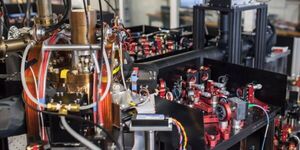
Quantum errors made more tolerable
"ETH physicists have modified one of the major schemes for quantum error correction and put it into practice, demonstrating that they can substantially prolong the lifetime of quantum states — a crucial ingredient for future large-scale quantum computers. In modern computing devices, literally billions of transistors work restlessly in almost perfect harmony. The keys to producing near-perfect computation from devices made from imperfect components are the use of digitisation and error correction, with the latter encompassing procedures to detect and rectify inaccuracies as they occur. The challenge of preventing errors from accumulating is one that future quantum computers have to face as well — in fact it forms the main barrier to realizing useful computations. Alas, the tools that have been perfected for classical computers cannot be applied directly to quantum computers, which play by another set of rules, those of quantum mechanics. Ingenious solutions for quantum error correction have been proposed over the past couple of decades, and recently there has been encouraging progress towards implementing such methods in state-of-the-art quantum computers." [...]
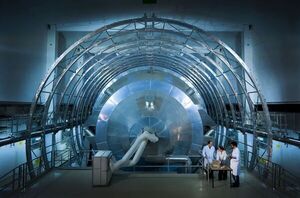
Berkeley Lab Researchers, Computational Facilities Play Key Role in Barrier-Breaking Neutrino Mass Measurement
"An international research team that includes Lawrence Berkeley National Laboratory (Berkeley Lab) scientists has established a new upper limit of 0.8 electron volts (eV) for the mass of the neutrino, a milestone that will bear on future discoveries in nuclear and particle physics, and cosmology. Indeed, without a measurement of the mass scale of neutrinos – extremely light subatomic particles once thought to be beyond measurement – physicists say their understanding of the universe would remain incomplete. An electron volt is defined as the energy that an electron gains when it travels through a potential of one volt. The research team, known collectively as the Karlsruhe Tritium Neutrino Experiment (KATRIN), located at Germany’s Karlsruhe Institute of Technology (KIT), published their findings Feb. 14 in the journal Nature Physics. Some of the statistical analysis used to determine the neutrino mass was performed using the Cori supercomputer at Berkeley Lab’s National Energy Research Scientific Computing Center (NERSC). This push into the sub-eV mass scale of neutrinos by a model-independent laboratory method, the KATRIN team says, has allowed them to constrain the mass of these so-called lightweights of the universe with unprecedented precision." [...]
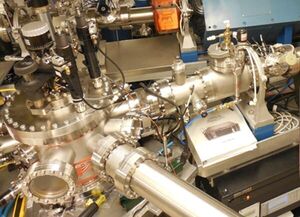
Fusion materials research powered by new DOE funding
"ARPA-E program awards Laboratory-led materials project $3.1 million; Laboratory partners on two other projects. The promise of fusion – a potentially game-changing source of low-cost, abundant energy – is constrained by a number of challenges, central among them the lack of materials that can withstand the extreme environments created in fusion reactions. Now $3.1 million in funding from the Department of Energy’s Advanced Research Projects Agency-Energy (ARPA-E) OPEN 2021 program will fuel a Los Alamos National Laboratory project to develop novel, tungsten-based alloys that can be used in fusion reactors. The material’s unique design and fabrication potential means that the future of fusion power might be closer than ever before. “In fusion, the generation of energy is typically not the main problem,” said Osman El Atwani, materials scientist with the Lab’s Materials Science in Radiation and Dynamics Extremes group and the project’s principal investigator. “The challenge of fusion is finding materials that can accept these conditions." [...]

Holistic contextual AI-based document processing
"ETH LegalTech spin-off DeepJudge assists law firms, corporations, and courts by making data-sensitive administrative work more efficient. How many of us have struggled when needing to replace a word or combination of words in a text? Law firms or corporate legal departments are no strangers to this, as they have hundreds of documents on each case and spend a significant amount of time on administrative work. Given the nature of legal documents, this is a complex task as it must consider elements such as anonymisation. What if part of this could be automated? This is where DeepJudge comes in." [...]
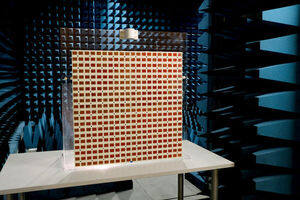
ITMO Researchers Create Light-Controlled Antenna for Fast and Secure 5G Data Transfer
"The new technology expands the coverage area even when the signal is weak by redirecting radiation from the base station to personal gadgets, drones, sensors, and other devices in the network. Compared to analogous devices, the new antenna is more energy-efficient, cheaper to produce, and has a simple adaptable design. More and more devices need to be constantly connected to a mobile network – not only mobile gadgets but also smart home systems, driverless cars, drones, and various sensors. 5G, the new wireless standard for mobile networks, is meant to support the performance of the annually growing number of such devices by using new frequency bands – up to 52 GHz. However, uninterrupted and fast data transfer at these frequencies is only possible within line of sight of base stations. Even an ordinary interior wall can significantly reduce the signal level." [...]

A new upper limit on the mass of neutrinos
"Researchers with the KATRIN experiment determine that neutrinos are lighter than 0.8 eV/c2. In a milestone that will bear on future discoveries in nuclear and particle physics, today an international team including scientists from MIT announced that they have established a new upper limit on the mass of the neutrino subatomic particle: 0.8 eV/c2. Physicists say their understanding of the universe would remain incomplete without a detailed understanding the mass scale of neutrinos. Now, scientists with Karlsruhe Tritium Neutrino Experiment (KATRIN), located at Germany’s Karlsruhe Institute of Technology (KIT), have pushed our understanding of neutrinos' mass with the new work, published in Nature Physics. MIT has been a member of the KATRIN experiment since 2005. MIT researchers have helped construct the simulation framework used to understand the detector and developed tools used for the data analysis." [...]
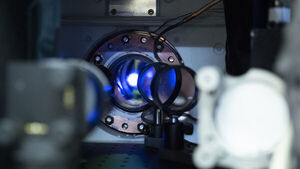
JILA Atomic Clocks Measure Einstein’s General Relativity at Millimeter Scale
"JILA physicists have measured Albert Einstein’s theory of general relativity, or more specifically, the effect called time dilation, at the smallest scale ever, showing that two tiny atomic clocks, separated by just a millimeter or the width of a sharp pencil tip, tick at different rates. The experiments, described in the Feb. 17 issue of Nature, suggest how to make atomic clocks 50 times more precise than today’s best designs and offer a route to perhaps revealing how relativity and gravity interact with quantum mechanics, a major quandary in physics. JILA is jointly operated by the National Institute of Standards and Technology (NIST) and the University of Colorado Boulder. “The most important and exciting result is that we can potentially connect quantum physics with gravity, for example, probing complex physics when particles are distributed at different locations in the curved space-time,” NIST/JILA Fellow Jun Ye said. “For timekeeping, it also shows that there is no roadblock to making clocks 50 times more precise than today — which is fantastic news.” Einstein’s 1915 theory of general relativity explains large-scale effects such as the gravitational effect on time and has important practical applications such as correcting GPS satellite measurements. Although the theory is more than a century old, physicists remain fascinated by it." [...]
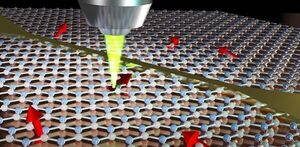
Two-dimensional material could store quantum information at room temperature
"Researchers have identified a two-dimensional material that could be used to store quantum information at room temperature. There are defects in this material that can emit single photons, which means it could be used in quantum systems Hannah Stern Quantum memory is a major building block to be addressed in the building of a quantum internet, where quantum information is securely stored and sent via photons, or particles of light. Researchers from the Cavendish Laboratory at the University of Cambridge, in collaboration with colleagues from UT Sydney in Australia, have identified a two-dimensional material, hexagonal boron nitride, that can emit single photons from atomic-scale defects in its structure at room temperature. The researchers discovered that the light emitted from these isolated defects gives information about a quantum property that can be used to store quantum information, called spin, meaning the material could be useful for quantum applications. Importantly, the quantum spin can be accessed via light and at room temperature. The finding could eventually support scalable quantum networks built from two-dimensional materials that can operate at room temperature." [...]
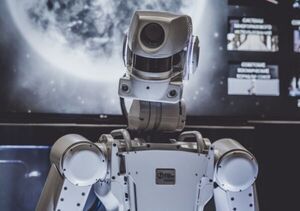
Should we ban killer robots?
"Lethal autonomous weapons systems demand careful consideration but nightmare scenarios of the future won't become reality anytime soon, says a UNSW Canberra military ethicist. The term ‘killer robots’ conjures up images of sci-fi scenarios where wars are being fought by Terminator-like soldiers, but according to UNSW Canberra military ethicist Deane-Peter Baker, it’s not quite that scary or cinematic. In fact, killer robots, or lethal autonomous weapons systems (LAWS), may actually save lives on the battlefield. Associate Professor Baker’s latest book, Should we Ban Killer Robots?, draws from his experience on the International Panel on the Regulation of Autonomous Weapons (IPRAW) from 2017-19. IPRAW is an international network of researchers tasked with providing non-partisan guidance to the national delegations engaged in the UN debate over whether or not to ban or regulate LAWS. “This book is my attempt to pull together my views on this topic, which have emerged from my time as an IPRAW panellist and other subsequent policy-focused work on this topic,” A/Prof." [...]
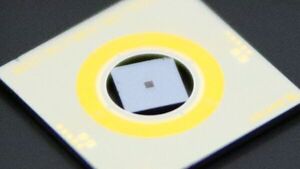
Researchers Combine Piezoelectric Thin Film and Metasurfaces to Create Lens with Tunable Focus
"For the first time, researchers have created a metasurface lens that uses a piezoelectric thin film to change focal length when a small voltage is applied. Because it is extremely compact and lightweight, the new lens could be useful for portable medical diagnostic instruments, drone-based 3D mapping and other applications where miniaturization can open new possibilities. “This type of low-power, ultra-compact varifocal lens could be used in a wide range of sensor and imaging technologies where system size, weight and cost are important,” said research project leader Christopher Dirdal from SINTEF Smart Sensors and Microsystems in Norway. “In addition, introducing precision tunability to metasurfaces opens up completely new ways to manipulate light.” Dirdal and colleagues describe the new technology in the Optica Publishing Group journal Optics Letters. To change focal length, a voltage is applied over lead zirconate titanate (PZT) membranes causing them to deform. This, in turn, shifts the distance between two metasurface lenses." [...]

Blocking microgrid cyberattacks to keep the power flowing
"Detection methods that identify the weaknesses in smart power grids will prevent cyberattacks from disrupting supply to critical infrastructure. Power grids have become far more complex in recent decades due to energy demands, environmental regulations and small-scale renewable energy systems that turn businesses and individuals into combined consumer-producers. One way to ensure that power supplies remain resilient is to create small groups of sources and loads called microgrids. Microgrids can operate independently of the main grid when required, such as supporting hospitals during natural disasters, for example. As microgrids grow more complex, they require sophisticated computer networks to coordinate, control and distribute different sources of power. Like any network, they are vulnerable to cyberattacks." [...]
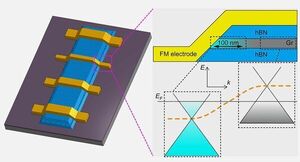
NGI advances graphene spintronics as 1D contacts improve mobility in nano-scale devices
"Researchers at The University of Manchester may have cleared a significant hurdle on the path to quantum computing, demonstrating step-change improvements in the spin transport characteristics of nanoscale graphene-based electronic devices. The team - comprising researchers from the National Graphene Institute (NGI) led by Dr Ivan Vera Marun, alongside collaborators from Japan and including students internationally funded by Ecuador and Mexico - used monolayer graphene encapsulated by another 2D material (hexagonal boron nitride) in a so-called van der Waals heterostructure with one-dimensional contacts (main picture, above). This architecture was observed to deliver an extremely high-quality graphene channel, reducing the interference or electronic ‘doping’ by traditional 2D tunnel contacts. ‘Spintronic’ devices, as they are known, may offer higher energy efficiency and lower dissipation compared to conventional electronics, which rely on charge currents. In principle, phones and tablets operating with spin-based transistors and memories could be greatly improved in speed and storage capacity, exceeding Moore’s Law. As published in Nano Letters, the Manchester team measured electron mobility up to 130,000cm2/Vs at low temperatures (20K or -253oC)." [...]

UChicago scientists create strange quantum ‘domain walls’ in laboratory
"Controlled for first time, quantum phenomenon could suggest avenues for technology University of Chicago scientists have been able to create a new kind of quantum object at will in the laboratory: “domain walls.” The discovery can help researchers better understand exotic quantum particles—and could suggest avenues for new technology in the future, such as quantum electronics or quantum memory. Published Feb. 2 in the journal Nature, the research was conducted in Prof. Cheng Chin’s lab, which studies novel quantum systems and the physics that underlie them. In one of their experiments, the UChicago scientists noticed an intriguing occurrence in atoms at extremely low temperatures. Under the right conditions, groups of atoms can segregate into domains, and a “wall” forms at the junction where they met. This domain wall behaved like an independent quantum object. “It’s kind of like a sand dune in the desert—it’s made up of sand, but the dune acts like an object that behaves differently from individual grains of sand,” said Ph.D. student Kai-Xuan Yao, the first author of the study." [...]

Electron conspiracy in a Japanese lattice pattern: kagome metals baffle science
"Toward a new kind of superconductivity: In the past four years scientists have discovered metals whose crystal structure mimics that of a traditional Japanese woven bamboo pattern: kagome metals. The international research activity in this new direction of quantum materials has recently reached a new climax: an international team of physicists has discovered that the underlying kagome lattice structure induces the joint appearance of intricate quantum phenomena which can lead to an unprecedented type of superconductivity. Ronny Thomale, member of the Würzburg-Dresden Cluster of Excellence ct.qmat, had theoretically predicted related effects in kagome systems 10 years ago. His ideas have contributed to the foundation upon which contemporary experiments on kagome metals are understood and interpreted. A recent milestone in the experimental discovery of exotic superconductivity in kagome metals has now been published in the Nature magazine. Atoms form a kagome pattern A kagome pattern is composed of three shifted regular triangular lattices." [...]

Superfluids provide new insight into turbulence
"Eddies in an exotic liquid known as a superfluid merge to form large vortices, analogous to how cyclones form in the turbulent atmosphere. The new research, by a team from The University of Queensland, the ARC Centre of Excellence for Engineered Quantum Systems (EQUS) and the ARC Centre of Excellence in Future Low-Energy Electronics Technologies (FLEET) will be important for emerging technological applications of superfluidity, such as precision sensing. Lead author and theorist Dr Matt Reeves said the team’s results provide experimental validation of a 70-year-old theory – a model for two-dimensional vortex equilibrium by Nobel Laureate Lars Onsager. “Large, long-lived vortices like cyclones or Jupiter’s Great Red Spot often form out of turbulent fluid flows, such as the atmospheres of planets,” he said. “Onsager’s model explains the existence of these structures, but so far experiments have tended to conflict with the predictions,” he said. “A key complication is that most fluids are viscous, meaning they resist flow." [...]
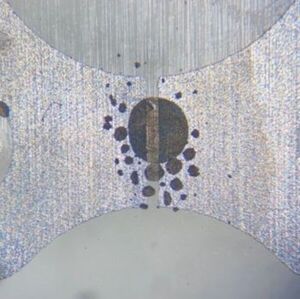
The University of Sussex scientists advancing liquid electronics
"New research from physicists at the University of Sussex will ‘significantly advance’ the new technology area of liquid electronics, enhancing the functionality and sustainability of potential applications in printed electronics, wearable health monitors and even batteries. In their research paper published in ACS Nano, the Sussex scientists have built on their previous work to wrap emulsion droplets with graphene and other 2D materials by reducing the coatings down to atomically-thin nanosheet layers. In doing so they were able to create electrically-conducting liquid emulsions that are the lowest-loading graphene networks ever reported – just 0.001 vol%. This means that the subsequent liquid electronic technology – whether that might be strain sensors to monitor physical performance and health, electronic devices printed from emulsion droplets, and even potentially more efficient and longer-lasting electric vehicle batteries, will be both cheaper and more sustainable because they will require less graphene or other 2D nanosheets coating the droplets. Another significant development was that the scientists can now make these electronic droplet networks using any liquids – whereas previous research focused on conventional oils and water – because they have discovered how to control which liquid droplets are wrapped in graphene, meaning that they can design the emulsions specifically to the desired application. Research Fellow in Material Physics in the University of Sussex School of Mathematical and Physical Science and lead author of the paper, Dr Sean Ogilvie explains the science behind the development: “The potential of 2D materials, such as graphene, is in their electronic properties and their processability; we developed a process to harness the surface area of our nanosheet dispersions to stabilise emulsion droplets with ultra-thin coatings." [...]
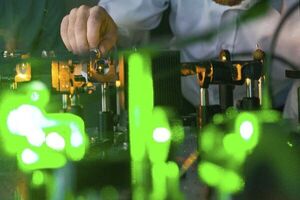
Uncovering unexpected properties in a complex quantum material
"Using a novel technique developed at Penn, researchers gained new insights into the properties of a proposed excitonic insulator known as Ta2NiSe5, with implications for future quantum devices. Anew study describes previously unexpected properties in a complex quantum material known as Ta2NiSe5. Using a novel technique developed at Penn, these findings have implications for developing future quantum devices and applications. This research, published in Science Advances, was conducted by graduate student Harshvardhan Jog and led by professor Ritesh Agarwal in collaboration with Penn’s Eugene Mele and Luminita Harnagea from the Indian Institute of Science Education and Research. While the field of quantum information science has experienced progress in recent years, the widespread use of quantum computers is still limited. One challenge is the ability to only use a small number of “qubits,” the unit that performs calculations in a quantum computer, because current platforms are not designed to allow multiple qubits to “talk” to one another." [...]
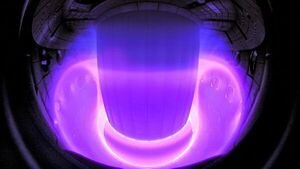
EPFL and DeepMind use AI to control plasmas for nuclear fusion
"Scientists at EPFL’s Swiss Plasma Center and DeepMind have jointly developed a new method for controlling plasma configurations for use in nuclear fusion research. EPFL’s Swiss Plasma Center (SPC) has decades of experience in plasma physics and plasma control methods. DeepMind is a scientific discovery company acquired by Google in 2014 that's committed to ‘solving intelligence to advance science and humanity. Together, they have developed a new magnetic control method for plasmas based on deep reinforcement learning, and applied it to a real-world plasma for the first time in the SPC’s tokamak research facility, TCV. Their study has just been published in Nature. Tokamaks are donut-shaped devices for conducting research on nuclear fusion, and the SPC is one of the few research centers in the world that has one in operation." [...]
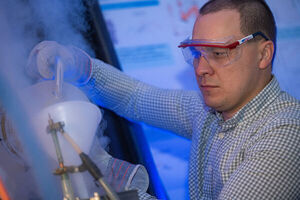
Strong magnets put new twist on phonons
"Phonons are collective atomic vibrations, or quasiparticles, that act as the main heat carriers in a crystal lattice. Under certain circumstances, their properties can be modified by electric fields or light. But until now, nobody noticed they can respond to magnetic fields as well. That may be because it takes a powerful magnet. Rice University scientists led by physicist Junichiro Kono and postdoctoral researcher Andrey Baydin triggered the unexpected effect in a totally nonmagnetic semiconducting crystal of lead and tellurium (PbTe). They exposed the small sample to a strong magnetic field and found they could manipulate the material’s “soft” optical phonon mode." [...]

Photocatalysis: the Nano-Sponge Revolution
"Creating a sponge-like hole structure on the nanometre scale that allows small molecules to pass through, record-breaking chemical reactivity was achieved. Catalysts are often solid materials whose surface comes into contact with gases or liquids, thereby enabling certain chemical reactions. However, this means that any atoms of the catalyst that are not on the surface serve no real purpose. Therefore, it is important to produce extremely porous materials, with as large a surface area as possible per gram of catalyst material. Scientists at TU Wien (Vienna), together with other research groups, have now developed a new method to produce highly active sponge-like structures with porosity on the nanometre scale. The decisive breakthrough was achieved through a two-step process: metal-organic frameworks (MOFs) are used, which already contain many tiny holes." [...]
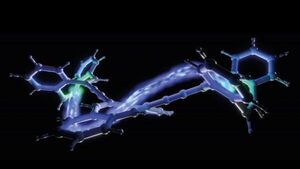
Researchers create molecule that can pave way for mini-transistors
"Researchers at Lund University in Sweden have succeeded in developing a simple hydrocarbon molecule with a logic gate function, similar to that in transistors, in a single molecule. The discovery could make electric components on a molecular scale possible in the future. The results are published in Nature Communications. Manufacturing very small components is an important challenge in both research and development. One example is transistors – the smaller they are, the faster and more energy efficient our computers become. But is there a limit to how small logic gates can become?" [...]

Algorithm could shorten quality testing, research in many industries by months
"Machine learning used to predict direction-dependent mechanical properties of metals. A machine-learning algorithm developed at Sandia could provide auto manufacturing, aerospace and other industries a faster and more cost-efficient way to test bulk materials. The technique was published recently in the scientific journal Materials Science and Engineering: A. Production stoppages are costly. So, manufacturers screen materials like sheet metal for formability before using them to make sure the material will not crack when it is stamped, stretched and strained as it’s formed into different parts. Companies often use commercial simulation software calibrated to the results of various mechanical tests, said Sandia scientist David Montes de Oca Zapiain, the lead author on the paper." [...]
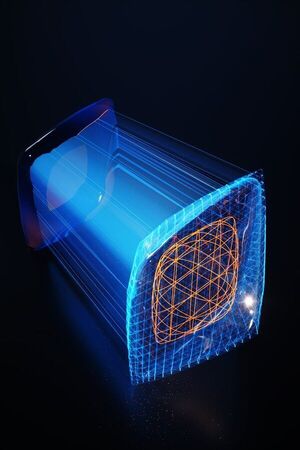
Stanford scientists combine AI and atomic-scale images in pursuit of better batteries
"Using artificial intelligence to analyze vast amounts of data in atomic-scale images, Stanford researchers answered long-standing questions about an emerging type of rechargeable battery posing competition to lithium-ion chemistry. Today’s rechargeable batteries are a wonder, but far from perfect. Eventually, they all wear out, begetting expensive replacements and recycling. “But what if batteries were indestructible?” asks William Chueh, an associate professor of materials science and engineering at Stanford University and senior author of a new paper detailing a first-of-its-kind analytical approach to building better batteries that could help speed that day. The study appears in the journal Nature Materials. Chueh, lead author Haitao “Dean” Deng, PhD ’21, and collaborators at Lawrence Berkeley National Laboratory, MIT and other research institutions used artificial intelligence to analyze new kinds of atomic-scale microscopic images to understand exactly why batteries wear out." [...]
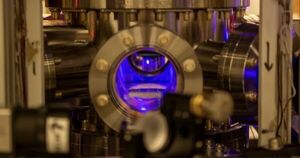
Ultraprecise atomic clock poised for new physics discoveries
"University of Wisconsin–Madison physicists have made one of the highest performance atomic clocks ever, they announced Feb. 16 in the journal Nature. Their instrument, known as an optical lattice atomic clock, can measure differences in time to a precision equivalent to losing just one second every 300 billion years and is the first example of a “multiplexed” optical clock, where six separate clocks can exist in the same environment. Its design allows the team to test ways to search for gravitational waves, attempt to detect dark matter, and discover new physics with clocks. “Optical lattice clocks are already the best clocks in the world, and here we get this level of performance that no one has seen before,” says Shimon Kolkowitz, a UW–Madison physics professor and senior author of the study. “We’re working to both improve their performance and to develop emerging applications that are enabled by this improved performance.” Atomic clocks are so precise because they take advantage of a fundamental property of atoms: when an electron changes energy levels, it absorbs or emits light with a frequency that is identical for all atoms of a particular element. Optical atomic clocks keep time by using a laser that is tuned to precisely match this frequency, and they require some of the world’s most sophisticated lasers to keep accurate time." [...]
Documentação
A documentação é parte essencial do processo de aprendizagem e a Internet além de artigos interessantes de explorar também tem alguma documentação em formato PDF interessante de ler. Todos os links aqui apresentados são para conteúdo disponibilizado livremente pelo editor do livro.
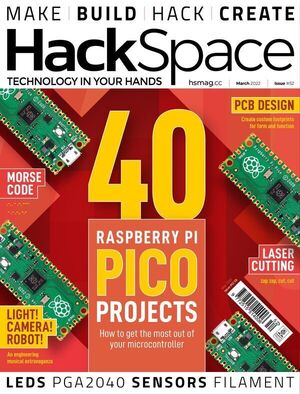
HackSpace magazine #52
"The Raspberry Pi Pico: it costs pennies, it’s simple to program with, and it’s really good at getting data in and out. In short, it’s the ideal board for home projects. We’ve hunted high and low for the best, most innovative, most creative projects around to show off what the Pico can do. What will you build with yours? Discover an innovative spin on PCB design Upcycled LED lights Learn (and use) Morse code An all-singing, all dancing toilet-cleaning robot" [...]
Projetos Maker
Diversos Projetos interessantes.
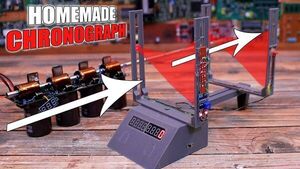
Arduino Chronograf
"This project is for a homemade chronograph and this device is used to measure muzzle speed which basically is the speed of bullets. If you remember, a few weeks ago I’ve made a coil gun project, which by the way was very powerful and I recommend you to watch that video as well. Anyway, if I want to know the speed of that metal projectile, I need such project. Basically, this device will measure the time between the input and output of the bullet and will give us the speed in meters per seconds. Is a very easy to make project, but I hope you will learn something new. I will show you what we need to make it, the schematic, the code, how to assemble everything and then we will test it out and see if it works." [...]
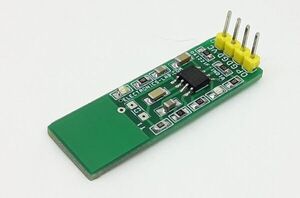
Single Key Touch Sensor using LM2907
"This is a single key device featuring a touch ON (Momentary) output. The project is built using the LM2907 chip. The board provides stable sensing and has a wide working power supply range 5V to 12V DC and consumes 20mA. D1 power LED, D2 function LED. Touch sensors are used in many applications, from remote controls, LED light controls to appliance control panels. This is a simple solution to replace a mechanical button and can be implemented in a wide variety of applications." [...]

Easy Light Board
"During the pandemic, teachers have often been abruptly moved online. Keeping students engaged and interested is what teachers love to do, and that can be tough when you're online and at home with limited resources. Here's a way of quickly and easily making a very accessible DIY lightboard that requires no construction skills beyond the use of tape and clamps, and is very easy to store compactly. To record yourself in action, you'll also need a tripod and a phone. I found the lightboard to be great for producing compelling problem-solving clips or quick tutorials, because as an instructor you're much more "there" in the recording than you are as a disembodied voiceover. Supplies: You need an LED strip, some tape, a 24 × 36" sheet of acrylic and some one-handed clamps." [...]

Vectron VGA Plus Text Mode
"Vectron VGA Plus Text Mode simplifies displaying text with retro computers and microcontrollers by hiding the pixel-level details. Supply only row and column positions, and an ASCII character code, to write text to a 40x30 character VGA display. How It Works Vectron VGA Plus Text Mode accepts row, column, and character codes into 8-bit flip flop registers from external systems. Using a 6502 processor and pre-programmed ROM chip (code here), these values are translated into a series of pixels to be drawn at x, y coordinates on the screen. Both the program, and the library of available ASCII characters are stored in the ROM. Instructions to draw each pixel are stored in 8-bit flip flop output registers where they can interface with and control a Vectron VGA Plus VGA adapter." [...]
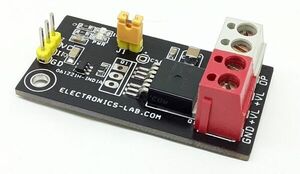
High Current MOSFET Based Power Switch with Gate Driver
"This power load switch project provides a simple and inexpensive method for power control. It is intended for driving a resistive or inductive load. A TTL logic signal from the system turns the load switch ON and OFF. The project consists of a low ohm N-Channel Power Trench MOSFET FDB0300N1007L and Gate driver MAX5048 chip. The load can be controlled by applying a PWM signal or Logic input. The MAX5048A is a high-speed MOSFET driver capable of sinking/sourcing 7.6A/1.3A peak currents." [...]
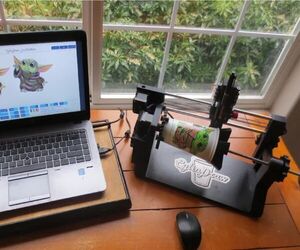
CylinDraw! a Cup-Specific Plotter & Engraver
"This is the CylinDraw, a new tool that lets you easily create incredible art on any kind of cup! CylinDraw essentially does 2 things: It can engrave & it can paint. And it is highly adjustable so it can do those 2 things on any kind of cup. (tumblers, wine glasses, mason jars, shot glasses, mugs with handles, or any cylindrical object tapered or not under 3” diameter & 11” tall). This is a large body of work and there is a lot to cover, so the introduction & demonstration video is a good place to start. If you want to be the first to hear when kits become available then visit the project homepage and enter your email address." [...]

Arduino RF24 MIDI Interface
"One thing I’ve wanted to try is wireless MIDI. I know you can get MIDI over Bluetooth (there are some rather neat commercial “wireless 5-pin MIDI” adaptors you can buy) and I believe people have used MIDI over Wi-Fi by using ipMIDI (“MIDI over Internet Protocol”). But I’ve had some cheap nrf24L01 radios for a while and so far have not done anything with them yet, so I thought I’d try to use them as a MIDI link. As with my I2C experiments, this is a very early (read draft, use-at-your-own-risk, very likely to change) implementation of an RF24 transport for the Arduino MIDI Library. Parts list * 2x Arduino Uno, Nano, or similar * 2x NRF24L01 radio modules * Optional: 8 ohm speaker or old headphone speaker * Optional: 1x 220Ω resistor * Optional: Arduino MIDI Interface * Breadboard and jumper wires" [...]
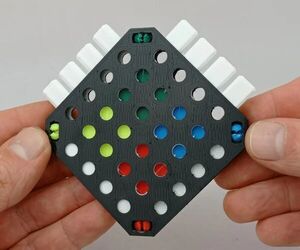
4x4 Colour Dot Puzzle
"Hey, this one is for all you puzzle fanatics out there!! So I've been conjuring up a few game designs recently and I came up with this 1 player game puzzle that I find quite interesting basically if a Rubik's cube and a 15 puzzle had a baby this would most probably be the result. The aim of the game is to rearrange the 16 coloured tiles in a way that all the 4 different colour tiles form four 2x2 squares within a 4x4 square. IMPORTANT UPDATE: This 4x4 Colour Dot Puzzles 3D printable files have since been updated with a faster printing smaller more reliable design The initial files are still available but I recommend downloading the new improved design files at the bottom of this Instructable in the Update section. " [...]
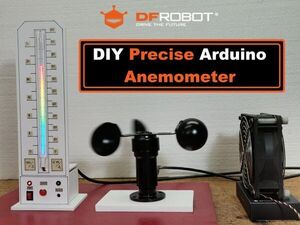
DIY Precise Arduino Anemometer with Linear Scale - DFRobot
"How to make a how to make a simple Arduino device where the value of wind intensity is presented on RGB Led strip. Anemometer is an instrument that measures the speed of the wind. It consists of a series of cups mounted at the end of arms that rotate in the wind. The speed with which the cups rotate indicates the wind speed. In this case, the speed of rotation of the Cups is proportional to the voltage on the yellow wire. This voltage ranges from 0 V to 5 V depending on the wind speed from 0 to 100 km / h. Then we bring this signal to the analog input of the microcontroller." [...]

Privacy Respecting Nanoleaf Replacement Light Panels
"In the following I am going to describe my own version of the light panels that, in my view, eliminate all the disadvantages of the commercial products while keeping all the advantages. I am aware that others have made similar light panels. I am making and publishing my own version, because although I have seen many that had very nice features, but I haven’t seen one that combined all of the features important to me in one product. As many others, I also like the concept of the Nanoleaf light panels. They have features that, in general, I appreciate and strive for in my own development efforts as well. The major advantages are: * Modular design – You can combine as few or as many (basic building blocks) as you want." [...]
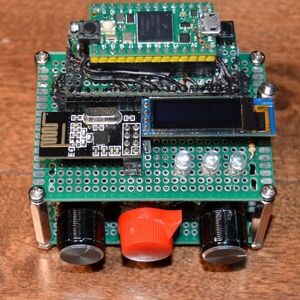
PendulumSynth
"PendulumSynth is an on-going and open-source project with the goal of mixing real-world physics into music composition and performance. PendulumSynth is an on-going and open-source project, running on Arduino platform with the goal of mixing real-world physics into music composition and musical performance. A network of pendulums with built-in IMU systems can be used to create rhythms and effects, manipulating music in real-time. It receives motion data from the pendulum and converts it into USB MIDI or CV so the output can be used for any synthesizer or DAW. The data is transmitted wirelessly so the IMU (pendulum) only needs power lines. At the moment, the host device only supports one IMU system but the goal is to support more through the NRF network." [...]

Penkesu Computer - A Homebrew Retro-style Handheld PC
"Penkēsu (Japanese: ペンケース) is a retro-style handheld device powered by a Raspberry Pi Zero 2 W, a 7.9 inch widescreen display (400 x 1280 resolution), and a 48-keys ortholinear mechanical keyboard. Display * Waveshare 7.9inch Capacitive Touch Screen * Adafruit DIY HDMI Cable Parts - Right Angle adapter, Mini HDMI adapter, and 20cm Ribbon Cable Case * Gameboy Advance SP Replacement Hinges * 3D printed parts (STL files and STEP file) Electronics * Raspberry Pi Zero 2 W * 3.7V 606090 (or similar size) Li-Po battery * Adafruit PowerBoost 1000C Keyboard * Kailh Low Profile Choc v1 Switches x 48 * MBK Choc Low Profile Keycaps x 48 * 1N4148 Diode x 48 * Arduino Pro Micro x 1 * PCB x 1 (gerber file and QMK firmware)" [...]

TshWatch - Not yet another esp32 watch :)
"Esp32/eink watch, core feature - ulp coprocessors drivers for i2c modules rtc, skin temperature, pedometer, air humidity/pressure. Project have started 2 years ago, as attempt to create a smartwatch with pedometer, hr sensor and skin temperature sensor. I wanted to collect big data about my activity and sync this data to my server when I can process it. That's why MCU chip should have wireless feature, and work pretty fast :) I haven't wanted to create yet another fancy smart watch, I wanted to create tool which helps people understand their state, which may say something about peoples state based on previous actions. I don't want to have continues connection with phone or wifi (at least for now), watch only collect data, process it and show some messages and digits, for example: you under stress now, your galvanic skin resistance increase your temperature higher than normal you haven't moved for long time, plz do something you have strange temperature change pattern every month. At that time I haven't any experience in creating any electronics, especially battery devices." [...]
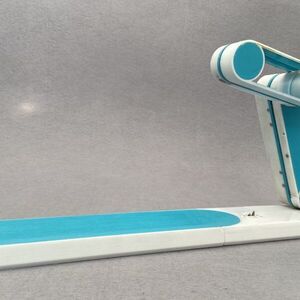
Akurobatto
"A clock that flips like an acrobat Akurobatto is the continuation of my quest to have a clock with arms that balance on an edge. The first of the series being the edgytokie which had shifting arms but had a major drawback of the hour and minute arms being same and were hard to differentiate. To overcome that limitation I set out to make one where there were arms with different sizes. I achieved that by having arms that could unlock themselves from the base and flip over. The clock consists of the tops arms and the bottom base. The long arm contains 2 stepper motors, The arduino and the stepper drivers." [...]

Infrared remote control clone utility
"IR Clone is an open-source infrared remote control signal analysis and generating tool. IR Clone is an open-source IR remote control analyzer tool. This utility can analyze any IR remote control that modulates the IR signal with a 38kHz carrier signal. This utility has an option to store and retrieve up to 16 IR signals. In addition, it has PC software to analyze and edit captured IR signals. The hardware component of this analyzer is built around the STM8S003F3 MCU." [...]
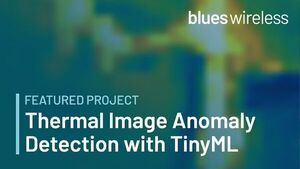
Thermal Image Anomaly Detection with TinyML
"Build an anomaly detection ML model with Edge Impulse based on thermal images, with data sent over cellular to the cloud via the Notecard. When I say "anomaly detection" you may imagine an overly complicated process, something exclusive to deep learning algorithms and indecipherable coding. In reality, the concept of uncovering anomalous behavior in a system is really just the act of identifying an unclassified or uncertain state. In the two Machine Learning projects I've published here on Hackster (an ML speed trap and remote birding), I've created ML models with different data inputs, and asked them to generate inferences based on the known data provided. But what happens when I ask the model to create an inference about something it doesn't know? This, in essence, is what I tried to accomplish in this project." [...]
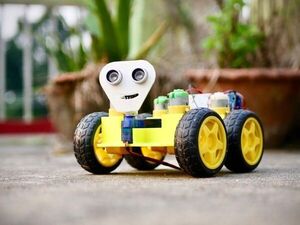
Obstacles Avoiding Smart Car Using Arduino
"Obstacles Avoiding Smart Car Using Arduino In this tutorial we make simple project on Obstacle Avoiding Robot using Arduino. It is an Arduino based robot car that uses Ultrasonic Sensors to avoid obstacles. I hope to do step by step guide on making this robot in very easy way. Here’s a video of the build and the car running. Read on for the full step by step instructions Hardware Required - Arduino Uno - Ultrasonic HC – SR04 sensor - Motor Driver IC – L293D - Servo Motor (Tower Pro SG90) - Geared Motors x 2 - Robot Chassis - 18650 Battery - battery Holders" [...]
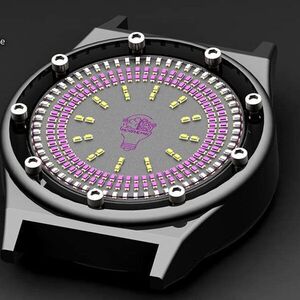
The 603-200 watch
"This watch has 200 leds and an ESP32 pico for superb light shows I am building this ESP32 pico watch. It had wifi, BT, mesh, a vibration motor, a RTC, 4 buttons, an usbC connector and, most of all: 192 603 leds you can control. They allow complex light effects. There are 4 circles of LEDS. The external is for the seconds and will be white. The 2 mid circles are purple for the minutes,." [...]
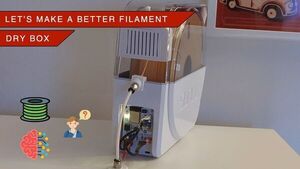
DIY Filament Dry Box
"In the past, I’ve used several filament dry boxes, but none of them had all the features that I wanted or even what I thought every filament dry box should have by default. So I decided to make my own. As always all the source files are available in case you decide to build one for yourself. But either way, you can watch the video and maybe pickup few ideas and improve on them. So, let’s make an awesome controller for 3D printing filament dry box! The idea behind the dry box is fairly simple; put a heater inside a box and it will keep it at a desired temperature, add a desiccant to absorb the moisture and add a fan to force air circulation." [...]
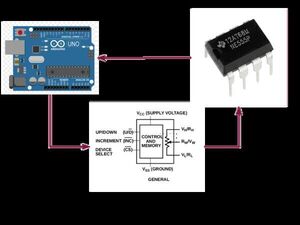
Pseudo Phase Locked Loop with Arduino and X9C104 pot
"How to use the Arduino with a X9C104 pot to implement a pseudo Phase Locked Loop square wave generator This project shows how to use the Arduino with a X9C104 to implement a frequency generator such that the frequency is optimized using a feedback loop. This is the principle used in a PLL circuit. This project shows how a X9C104 IC is controlled by an Arduino and used in a feedback loop with a 555 Timer circuit to output a user required input frequency. This frequency is set close to the input by using a feedback loop connected to an Arduino interrupt. The basic principle of operation: - User inputs a required frequency via the Arduino serial monitor. - Arduino accepts input and programs X9C104 to an initial setting - X9C104 resistance in 555 timer circuit adjusts frequency of oscillation - The resulting square wave is fed back into the Arduino interrupt (pin 2) - Using an interrupt handling routine, the frequency of the square wave is determined - This frequency is compared with the required and adjustments are made to X9C104 - Frequency is measured again and a second optimization is performed - Frequency of output square wave from 555 timer settles to value set by user in step 1 X9CXXX Digitally Controlled Potentiometer (XDCP) The X9CXXX integrated circuits are manufactured by Intersil (recently acquired by Renesas Corporation) and represent their range of digitally controlled potentiometers." [...]

PRINT-A-SKETCH
"A Handheld Printer for Physical Sketching of Circuits and Sensors on Everyday Surfaces We present Print-A-Sketch, an open-source handheld printer prototype for sketching circuits and sensors. Print-A-Sketch combines desirable properties from free-hand sketching and functional electronic printing. Manual human control of large strokes is augmented with computer control of fine detail. Shared control of Print-A-Sketch supports sketching interactive interfaces on everyday objects – including many objects with materials or sizes which otherwise are difficult to print on. We present an overview of challenges involved in such a system and show how these can be addressed using context-aware, dynamic printing. Continuous sensing ensures quality prints by adjusting the inking rate to hand movement and material properties." [...]
Secção Videos
Videos interessantes.
That's all Folks!






